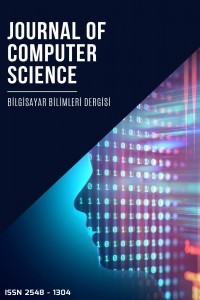Karcı ve Shannon Entropilerin Karşılaştırılması
Karcı entropi, Shannon entropi
Comparison Of Karcı And Shannon Entropies
Karcı entropy, Shannon entropy,
___
- [1] C.E. Shannon, A mathematical theory of communication, Bell Syst. Tech. J. 27 (1948) 379–423, 623–656.[2] S. Bouzebda, I. Elhattab, New Kernel-types Estimator of Shannon’s Entropy, Comptes Rendus Mathematique, vol. 352, Comptes Rendus de l’Académiedes Sciences–Series I–Mathematics, 2014, pp. 75–80.[3] M.R. Ubriaco, Entropies based on fractional calculus, Phys. Lett. A 373 (2009) 2516–2519.[4] A. Karcı, A new approach for fractional order derivative and its applications, Univ. J. Eng. Sci. 1 (2013) 110–117.[5] A. Karcı, Properties of fractional order derivatives for groups of relations/functions, Univ. J. Eng. Sci. 3 (2015) 39–45.[6] A. Karcı, The linear, nonlinear and partial differential equations are not fractional order differential equations, Univ. J. Eng. Sci. 3 (2015) 46–51.[7] A. Karcı, Generalized fractional order derivatives for products and quotients, Sci. Innov. 3 (2015) 58–62.[8] A. Karcı, Chain rule for fractional order derivatives, Sci. Innov. 3 (2015) 63–67.[9] A. Karcı, “Fractional order entropy New perspectives”, Optik - International Journal for Light and Electron Optics, vol:127, no:20, pp:9172-9177, 2016.
- ISSN: 2548-1304
- Yayın Aralığı: Yılda 2 Sayı
- Başlangıç: 2016
- Yayıncı: Ali KARCI
A Hidden Hazard: Man-In-The-Middle Attack in Networks
Ahmet EFE, Gizem KALKANCI, Mehmet DONK, Serhat CİHANGİR, Ziya UYSAL
Destek Vektör Makinasi Algoritması ile Kalp Hastalıklarının Tahmini
İrem OZCAN, Beyda TASAR, Ahmet Burak TATAR, Oguz YAKUT
Mahmut DİRİK, Adnan Fatih KOCAMAZ, Emrah DONMEZ
Evrişimsel Sinir Ağlarında Kullanılan Transfer Öğrenme Yaklaşımlarının İncelenmesi
Kazım FIRILDAK, Muhammed Fatih TALU
Konvolüsyonel Sinir Ağına Sahip Akıllı Kontrol Cihazları
Karcı ve Shannon Entropilerin Karşılaştırılması
Optimal Coverage of Wireless Sensor Networks Based On Artificial Algae Algorithm (AAA)
